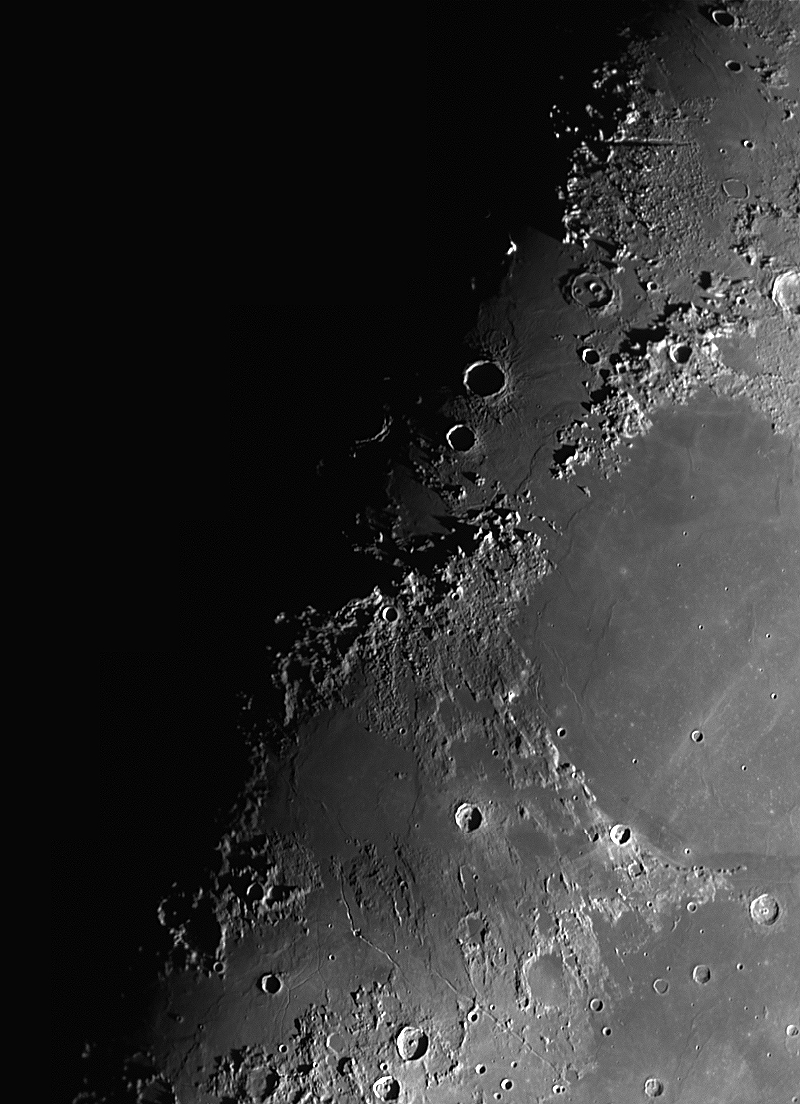Los Montes Alpes son una cadena montañosa de la luna, situada entre el Mare Imbrium y el Mare Frigoris. El nombre fue puesto por el astrónomo Johannes Hevelius en referencia a la cordillera de los Alpes terrestres.
La cordillera tiene una longitud de 281 km y una anchura máxima de unos 80 km, que alberga varios picos con una altura media de 2400 m. Viene delimitada en sus extremos por el cráter Platón en el noroeste y el cráter Cassini en el sureste. La cordillera se encuentra dividida en dos mitades por el Vallis Alpes (Valle de los Alpes), de 130 km de longitud y 11 km de anchura, bordeada por gargantas de 1000 m de altitud.
El pico más alto de la cordillera es el Mons Blanc con 25 km de anchura y 3600 m de altitud. En el extremo sureste de la cordillera se encuentran el Promontorio Deville, con una anchura de 16.56 km y una altura de 1300 m, y el Promontorio Agassiz, con una anchura de 18.84 km y una altitud de 2470 m.1 Los promontorios (promontorium) son el equivalente lunar de un cabo terrestre.
Los Montes Caucasus (Montes Cáucaso) son una cadena montañosa de la cara visible de la Luna, situada entre el Mare Imbrium y el Mare Serenitatis. El nombre procede de las Montañas del Cáucaso terrestres.
La cordillera tiene una longitud de 443 km y una anchura máxima de unos 100 km, cuyas cumbres, que culminan a 3500 m, están separadas por profundos valles. En su zona central se encuentra incrustado el cráter Calippus y los restos del cráter Alexander, y más hacia el norte los destacados cráteres Eudoxus y Aristóteles.
Al suroeste de la cordillera se encuentran los Montes Apenninus y los Montes Carpatus.
Los Montes Apenninus (Montes Apeninos) son una cordillera situada en la parte norte de la cara visible de la Luna, bautizada en alusión a los Montes Apeninos en Italia. La cadena montañosa, que es la más importante del satélite, se encuentra al sur de los Montes Alpes y tiene una longitud de casi 600 km, y su cumbre más alta es el Mons Huygens, con 5500 m de altitud.
Los Montes Apenninus forman el límite suroriental del Mare Imbrium y el noroccidental de la región de la meseta de Terra Nivium, y están situados inmediatamente al este del cráter Eratosthenes. Al oeste de los Montes Apenninus se encuentra una estrecha abertura que une el Mare Imbrium con el Mare Insularum, al sur. Más al oeste, se encuentran los Montes Carpatus.
Desde el cráter Eratosthenes, los Apeninos lunares se observan en forma de una cadena que gradualmente se arquea de este a noreste, terminando en el Promontorium Fresnel. Aquí hay otra abertura, donde el Mare Imbrium, al oeste, se une al Mare Serenitatis, al este. En la parte norte de esta brecha se encuentran los Montes Caucasus.
El nombre de Montes Apeninos se lo dio el astrónomo polaco Johannes Hevelius (1611-1687), siendo aprobado por la Unión Astronómica Internacional en 1961.
Los Montes Apenninus junto con los Montes Carpatus y los Montes Caucasus constituyen algunos de los fragmentos supervivientes del anillo exterior, de un conjunto original de tres, formados por el impacto que causó la formación de la cuenca del Mare Imbrium hace unos 3850 millones de años.3

